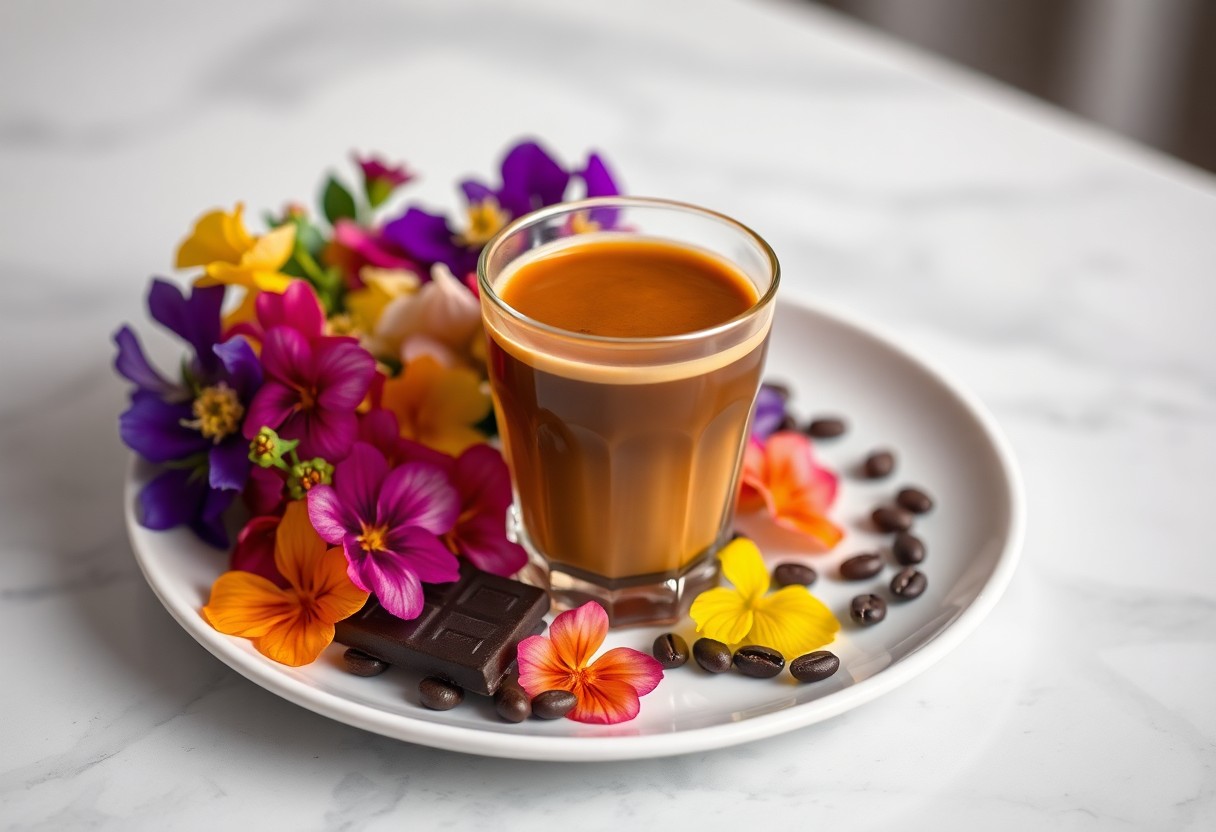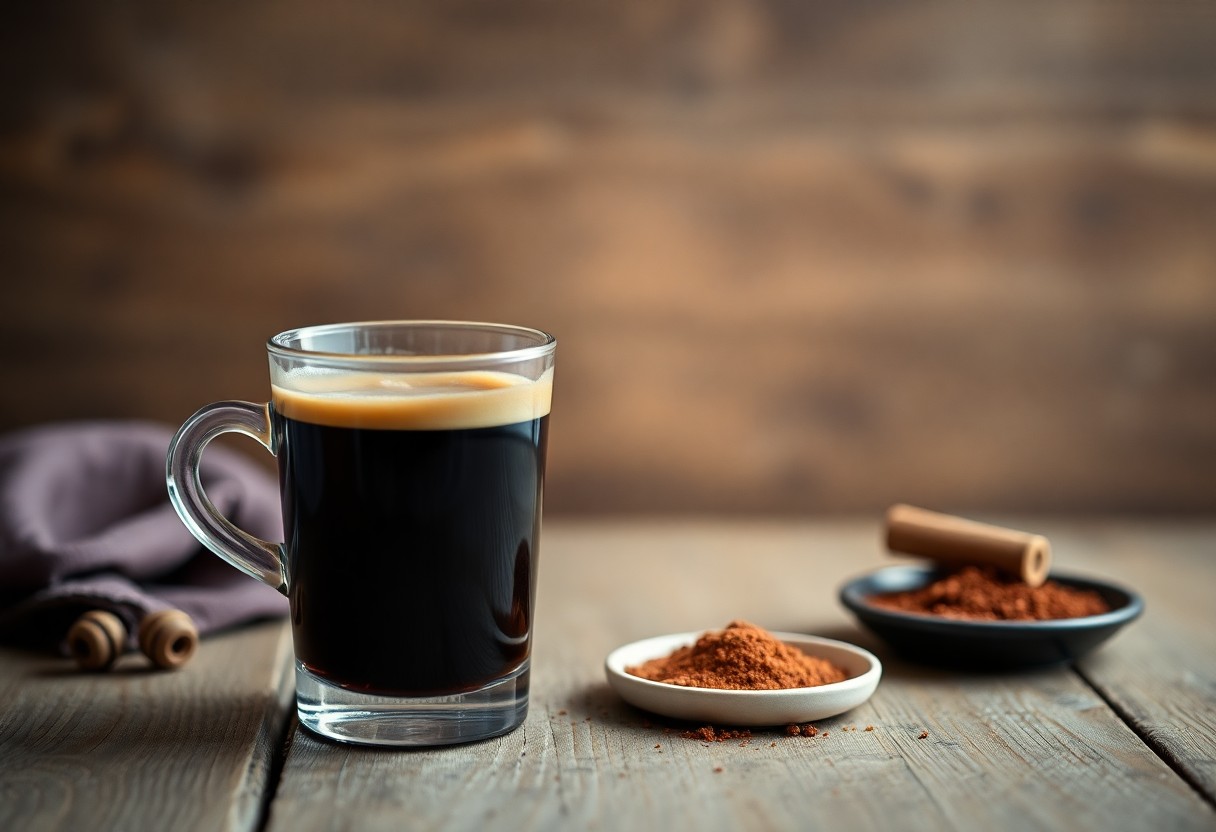Many coffee lovers seek a way to indulge in a dessert-style espresso that satisfies your sweet cravings while keeping it healthy. By utilizing natural flavor enhancements and spices, you can create a rich and flavorful espresso without the need for cream or sugar. In this guide, you’ll discover how to transform your daily brew into a guilt-free treat that delights your taste buds, using ingredients you probably already have on hand. Get ready to elevate your coffee experience with these easy-to-follow steps.
Key Takeaways:
- Utilize high-quality espresso beans to enhance flavor complexity and achieve a dessert-like taste without the need for cream or sugar.
- Incorporate additional flavors such as vanilla, cinnamon, or cocoa powder to elevate the espresso experience and create a delicious dessert-style drink.
- Experiment with different brewing techniques, like cold brew or espresso shots, to find the method that best complements the natural sweetness of the coffee beans.
The Art of Selecting Espresso Beans
Your choice of espresso beans significantly impacts the overall flavor of your dessert-style brew. Looking for beans that demonstrate a rich complexity allows you to explore various notes such as chocolate, caramel, or fruity undertones, all of which can enhance the experience of your espresso without the addition of cream or sugar. Selecting beans from reputable roasters who prioritize high-quality sourcing will lead you to discover unique varietals to perfectly suit your palate.
Understanding Flavor Profiles
Espresso beans come with distinct flavor profiles influenced by their origin, processing methods, and roasting levels. For instance, beans from Ethiopia often yield vibrant floral and berry notes, while those from Colombia may result in a sweeter, nutty essence. Exploring these flavor dimensions helps you identify which beans complement the dessert-style experience you’re aiming for.
Choosing Freshness Over Roasting Dates
Prioritizing the freshness of espresso beans can vastly improve your brew. Freshly roasted beans, ideally used within two to four weeks after roasting, will deliver optimal flavor and aroma. Aging beans, even if they have a recent roasting date, may lose their complexity and vibrant characteristics. Look for roasters that provide roast dates on their bags and buy smaller quantities to maintain freshness.
Whenever possible, purchase your espresso from local roasters where you can often find recently roasted beans. Consider trying direct trade coffees that emphasize ethical sourcing and sustainable practices; these tend to be fresher. Invest in proper storage as well—keep your beans in an airtight container away from light and moisture, ensuring they maintain their peak flavor for as long as possible. This attention to freshness can be the difference between a mediocre espresso and one that tantalizes your taste buds with its dessert-like qualities.
Mastering the Brewing Technique
Achieving the perfect dessert-style espresso requires more than just the right beans; mastering the brewing technique is vital to unlock the flavors you desire. With an understanding of equipment importants and the correct brewing parameters, you can transform a simple espresso shot into a sweet and satisfying experience without any added cream or sugar.
Equipment Essentials for Perfect Espresso
Quality equipment makes a significant difference in your brewing process. Invest in a reliable espresso machine or a moka pot, along with a good burr grinder to consistently produce uniform coffee grounds. An accurate scale allows you to measure your coffee and water precisely, ensuring the ideal extraction every time.
Brewing Parameters: Temperature, Time, and Pressure
Precision in temperature, time, and pressure dramatically affects the flavor profile of your espresso. Aim for a brewing temperature of around 90-96°C (194-205°F), maintaining a brew time of 25-30 seconds at a pressure of 9 bars. Adjusting these variables can lead to a range of flavors, allowing you to tailor the espresso to your specific taste preferences.
Brewing Parameters Table
| Parameter | Recommended Value |
| Temperature | 90-96°C (194-205°F) |
| Time | 25-30 seconds |
| Pressure | 9 bars |
Maintaining the ideal parameters is important for espresso extraction. Higher temperatures can lead to over-extraction, resulting in a bitter taste, while lower temperatures may under-extract, leaving the flavor weak. Similarly, adjusting the brew time allows you to experiment with varying taste profiles—longer extractions tend to emphasize sweetness, while shorter times can lead to a more acidic taste. By mastering these parameters, your dessert-style espresso can reach new heights of flavor without relying on any sugar or cream.
Impact of Brewing Parameters Table
| Parameter | Flavor Impact |
| Temperature | Balance between bitterness and sweetness |
| Time | Influences acidity and overall flavor complexity |
| Pressure | Determines extraction efficiency and body |

Crafting Flavor Without Cream or Sugar
Creating a dessert-style espresso without cream or sugar challenges you to explore various ingredients and techniques that elevate the experience. Flavor can be crafted through careful selection, using alternative sweeteners, and intensifying the natural notes already present in your espresso. By focusing on these elements, you can enhance your espresso’s richness, resulting in a satisfying and indulgent drink that stands on its own.
The Role of Alternative Sweeteners
Alternative sweeteners serve as effective substitutes for traditional sugar, allowing you to maintain a satisfying sweetness without added calories or refined sugar content. Options like stevia, monk fruit, and erythritol provide diverse flavors, each enhancing your espresso in unique ways. Stevia, for example, brings an earthy sweetness that complements chocolatey undertones, while monk fruit’s caramel notes evoke warmth and richness.
Enhancing Taste with Natural Flavors
Utilizing natural flavors can transform your espresso into a dessert-like delight. Consider adding vanilla extract or a pinch of cinnamon to elevate your drink. The sweetness of vanilla mimics the richness of cream, while cinnamon introduces a warm spice that works harmoniously with the coffee’s profile. Infusing your espresso with orange zest can also impart a bright, fresh undertone that refreshes the palate and enhances overall complexity.
Experimenting with other natural flavor enhancers can diversify your espresso experience. Infusions of flavored syrups made from herbs such as lavender or rosemary can add herbal notes, offering unexpected but delightful layers to your drink. You might also explore using small amounts of cocoa powder for a chocolatey essence that pairs beautifully with espresso. Whatever flavors you choose, integrating them thoughtfully will allow you to showcase the depth of your espresso while keeping the dessert-like sensation firmly intact.

Presentation: Turning Espresso into a Dessert Experience
You can elevate your espresso into a true dessert experience through thoughtful presentation. Consider serving your espresso in a unique glass or cup that enhances the visual appeal, such as a clear double-walled glass that showcases the rich crema on top. Pairing your espresso with a complementary tasting element, like a small piece of dark chocolate or a delicate almond biscotti on the side, adds an elegant touch. The overall setting, including a beautifully arranged saucer or a sprinkle of cocoa powder on the rim, will further enhance the aesthetics of your dessert espresso.
Creative Serving Ideas
Transforming your espresso into a visually appealing dessert involves some creative serving ideas. You might serve it in an elegant martini glass, or pair it with a small scoop of espresso sorbet for a chilled effect. Consider layering it over a base of warm apple compote for a playful contrast of textures. These unique presentations not only surprise the palate but also create a memorable dining experience that goes beyond the typical coffee routine.
Garnishing Techniques to Impress
Elevate your dessert espresso experience with impressive garnishing techniques. A simple twist of orange peel can enhance the aroma while a drizzle of flavored syrup, such as vanilla or caramel, adds depth. Incorporating edible flowers or a sprinkle of cinnamon on top offers a color contrast and invites curiosity. For an added touch of sophistication, consider serving with a side of whipped coconut cream, giving you the richness of cream without the heaviness of traditional dairy.
Utilizing garnishing techniques invites a sensory experience that engages more than just taste. For instance, the aromatic properties of ingredients—like a sprig of fresh mint or a few coffee beans—create that enticing aroma, reflecting the overall flavor profile. You can experiment with different spice blends like cardamom or nutmeg to give your espresso an exotic twist while engaging visually with colorful edible garnishes. This not only tantalizes the taste buds but also enhances the visual appeal, making each sip feel joyous and celebratory.
Elevating the Espresso Experience
Your espresso can go beyond a mere beverage and transform into an indulgent experience that tantalizes the taste buds. Taking time to explore flavors, aromas, and textures allows you to fully immerse yourself in the nuances of your brew. Think about exploring various methods of brewing or selecting beans with distinct flavor profiles to elevate your daily ritual. You could also consider using an infusion of spices such as cinnamon or nutmeg, which can create a delightful aromatic backdrop, enhancing your espresso enjoyment without added dairy or sugar.
Pairing with Non-Dairy Treats
Selecting the right non-dairy treats to accompany your espresso can enhance its flavor even further. Consider options like almond or coconut macaroons, which offer a satisfying crunch and a hint of sweetness. Alternatively, dark chocolate-covered espresso beans can amplify your coffee’s bitterness while introducing a rich, indulgent taste. You might also enjoy a slice of vegan chocolate cake, as the deep cocoa flavors can beautifully complement the espresso’s natural acidity.
Incorporating Unique Textures and Elements
Introduce a variety of textures to your espresso experience by experimenting with toppings and accompaniments. You could add a sprinkle of cacao nibs or crushed nuts to your drink for an enjoyable crunch, contrasting with the smoothness of the espresso. A dash of sea salt can provide a surprising twist, enhancing the drink’s inherent flavors. Consider serving the espresso cold over textured ice cubes made from coffee for a refreshing change. Try garnishing with a twist of orange zest to lend both complexity and aroma to your beverage.
When incorporating unique textures and elements into your espresso experience, think about how contrasting sensations can enhance your enjoyment. For instance, using coarse sea salt can create an unexpected but delightful contrast that accentuates the espresso’s natural bitterness while creating a harmonious and multi-layered flavor profile. You could also play with the combination of warm and cool elements – icy coffee cubes paired with hot espresso generate a delightful temperature play, while crunchy toppings introduce a satisfying mouthfeel. Each unique addition allows you to tailor your espresso experience to suit your personal palate. Consider these elements not just as accompaniments, but as integral parts of a well-rounded dessert-style espresso.
Final Words
With these considerations, you can now prepare a delightful dessert-style espresso without relying on cream or sugar. By utilizing ingredients like rich dark chocolate, vanilla extract, or flavored syrups, you can enhance the natural sweetness and complexity of your espresso. Experimenting with spices like cinnamon or nutmeg can also elevate your drink. Feel free to adjust the ratios to suit your personal taste, and enjoy your unique espresso creation that satisfies your dessert cravings without the added calories of traditional ingredients.
FAQ
Q: What type of coffee beans should I use for a dessert-style espresso?
A: For a dessert-style espresso, it’s best to use high-quality, specialty coffee beans. Look for beans with natural sweetness, such as those categorized as medium roast or light roast. Beans from regions like Ethiopia or Colombia often have fruity or chocolaty notes that contribute to a dessert-like flavor. Additionally, try to find beans that are specifically labeled for espresso to achieve that rich, concentrated taste.
Q: Can I use flavored coffee beans to enhance the dessert taste?
A: Yes, flavored coffee beans can enhance the dessert taste of your espresso. Options like vanilla, hazelnut, or caramel-flavored beans can add an extra layer of sweetness and complexity. However, it’s important to select high-quality flavored beans that use natural flavoring processes to avoid any artificial aftertaste. You can also experiment with different flavor profiles to find your perfect combination.
Q: How can I achieve a creamy texture without using cream?
A: To achieve a creamy texture without cream, you can use a milk alternative that froths well, such as oat milk or almond milk. Steam or froth the milk alternative before adding it to your espresso. Additionally, incorporating some frothed nut or oat milk can create that rich mouthfeel typically associated with cream-based desserts. You can even blend the espresso with a touch of milk alternative for a thicker consistency.
Q: What natural sweeteners can I use instead of sugar?
A: There are several natural sweeteners you can use to replace sugar in your dessert-style espresso. Options include honey, agave syrup, or maple syrup. Each of these sweeteners has its own flavor profile, so choose one that complements the espresso. Additionally, you could consider using stevia or monk fruit sweeteners for a low-calorie option. Start with small amounts and adjust to taste for the desired sweetness.
Q: Can I add spices to my espresso to enhance its dessert-like flavor?
A: Absolutely! Adding spices can elevate the flavor of your dessert-style espresso. Common spices to consider include cinnamon, nutmeg, or cardamom. Each spice adds warmth and depth, making your espresso feel more indulgent. Just a pinch can make a significant difference. You can either mix the spice into the espresso before brewing or sprinkle it on top after preparation for a delightful finishing touch.
